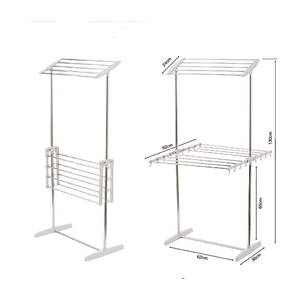
All categories
Featured selections
Trade Assurance
Buyer Central
Help Center
Get the app
Become a supplier

(981 products available)















A fabric drying stenter is a crucial piece of equipment for industries that require the treatment and drying of fabrics as per specific widths and lengths. With the advent of technological advancements, several types of fabric stenter machines have been developed to fulfill varying industrial needs.
A fabric drying stenter is a key processing machine in the textile industry. It is commonly used to dry various textile materials, such as cotton, wool, polyester, and blended fabrics. Besides that, it is also applied to heat-set the fabric. This helps to stabilize the size and shape of the fabric and improve its dimensional stability.
Moreover, the stenter machine is extensively used to finish the fabric. This includes processes such as coating, lamination, and impregnation, carried out on the stenter. These finishings enhance the fabric's performance and add value to the final textile product. A typical example would be to make the fabric water-resistant or flame retardant.
Many fabric drying stenter machines out there can be used to process a wide range of textile materials as well as to accommodate various fabric widths. Some have a high carrying capacity and could handle high-volume production. This makes the stenter suitable for use in large-scale textile factories and establishments. Most fabric stENTERs are easy to operate and can be integrated into automated production lines together with other textile processing machines. This makes it possible for a continuous and efficient fabric processing workflow.
In summary, the stentering machine has become an irreplaceable tool in modern textile production. It helps to ensure the final fabric products meet the quality standards required by most consumers across the globe.
When choosing fabric drying stenters for sale, buyers should look for the machine's material and construction. Strong stainless steel or alloy stentering machines will have durable and rust-resistant materials. Also, they will have sturdy constructions that provide stability during operations.
Additionally, buyers should get various fabric stentering machines with different heating methods to cater to diverse needs. Usually, the fabric drying stenter's heating method will affect the fabric's drying rate and quality. For instance, a steam stenter will be suitable for fabrics that require a gentle drying process, while electric stenters will have faster drying rates.
Moreover, buyers should get fabric stenters with adjustable width and temperature settings. Such options will allow end-users to modify the stenter to their specific fabric types and production requirements. Also, buyers should look for fabric stenters with energy-efficient features such as insulations and automatic controls. Such stenters will help end-users reduce energy consumption during drying processes.
Buyers should also consider fabric stenters with high production capacities if their target customers run large-scale operations. Such stenters will enable them to meet high demands. Additionally, buyers should consider fabric stenters with easy maintenance features such as self-cleaning programs and removable components. Also, stentering machines with maintenance prompts will notify end-users when it's necessary to service the machine.
Buyers should also get fabric stentering machines that are easy to operate. Such machines may have intuitive controls and automation features. Therefore, the operators will require minimal training to operate them efficiently. Also, tech support availability is an essential aspect that buyers should not overlook. Typically, fabric drying stenters with advanced technological systems may require specialized technical assistance. Therefore, buyers should ensure that the supplier offers access to qualified technicians who can provide prompt support whenever necessary.
Q1: What are recent trends in fabric drying stenter technology?
A1: Recent trends in fabric drying stenter technology include energy-efficient systems, automation and control, multi-function stenters, eco-friendly drying methods, and thermal recycling systems.
Q2: How can business buyers ensure the quality and performance of fabric drying stenters?
A2: Business buyers can ensure the quality and performance of fabric drying stenters by looking for stentering machines' international standards and certifications, sourcing from reputable fabric drying stenter suppliers, and seeking fabric drying stenter reviews and recommendations from other industry peers.
Q3: What are the potential challenges and risks associated with fabric drying stenters?
A3: fabric drying stenters may face some challenges, such as maintenance and repair, supply chain risks, technological obsolescence, and regulatory compliance.
Q4: Do fabric drying stenters have special requirements for installation and operation?
A4: The fabric drying stenter may have special requirements for installation and operation, such as electrical and air supply requirements, ensuring the machine's level and alignment, and specific operating and maintenance instructions.
Q5: What are the benefits of investing in high-quality fabric drying stenters?
A5: High-quality fabric drying stenters offer superior durability, stability, and reliability. They can withstand heavy use and provide consistent fabric drying quality over time. High-quality stenters are typically more energy-efficient, helping to reduce operational costs in the long run.